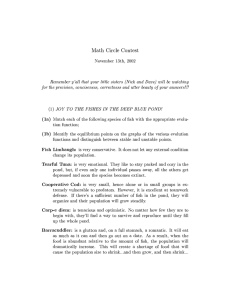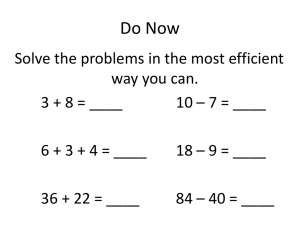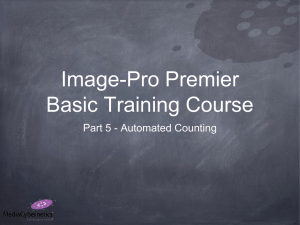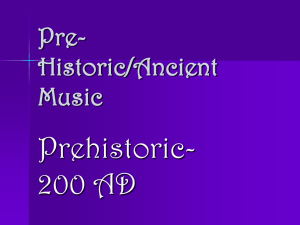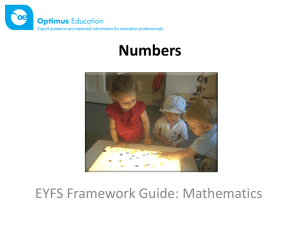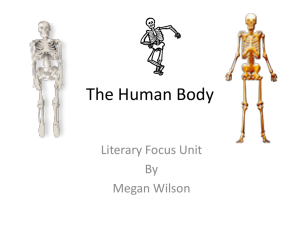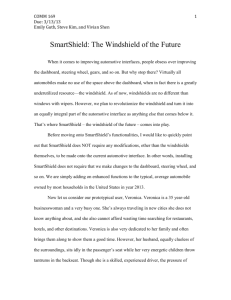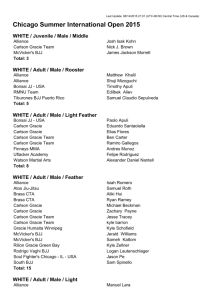Welcome to Number Sense K-2 - Region 11 Math And Science
advertisement
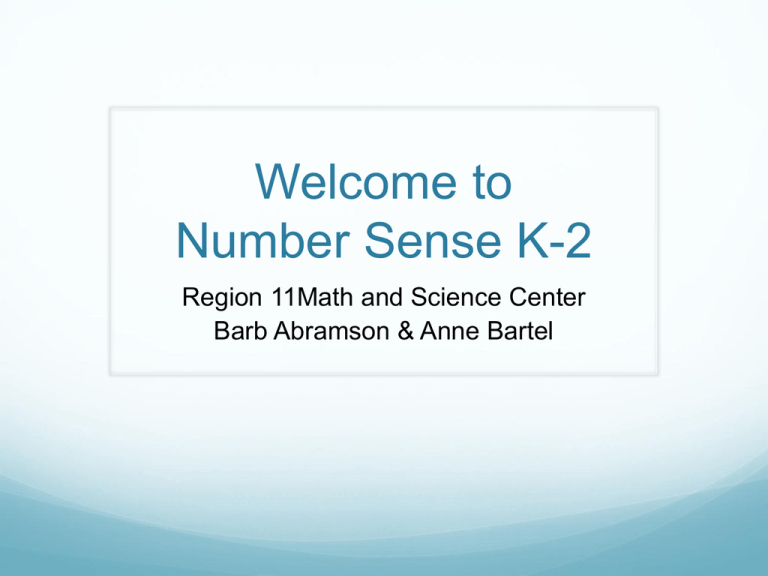
Welcome to Number Sense K-2 Region 11Math and Science Center Barb Abramson & Anne Bartel Step In – Step Out Form a large circle around all the tables and face each other. Step to the inside of the circle if the statement is true for you. Step In – Step Out I went to the MN Renaissance Fair this year. I drove more than 30 miles this morning to get here. I got up before 5 AM this morning. I teach 1st grade / 2nd grade / 3rd grade I know what CGI in math education stands for. I like teaching math better than reading Agenda & Parking Lot Housekeeping Details Timeframe Lunch Restrooms Wi-fi access Sign-in Norms “Misery is optional” Region 11 Math & Science Funded since 2007 Focus on 3-5 and 6-8 Focus this year on K-2: Number Sense with 450-500 teachers Registration Concerns Folder Contents This Year’s Goal Give teachers the time and opportunity to learn how students think about math… …in an incremental, job-embedded, and ongoing structure… …with support Good news and good news Teacher Assessment Anonymous – we don’t want to know who you are Code: Birthdate and first letter of your last name E.g., 0 4 1 5 4 8 B Take a Break Beloved Child Work in groups of 3 Think – Pair – Share What do you want for the child/children who is/are most important to you? In 20 years, what do you want these children to say about their memories of math? Our Goals All children motivated to learn challenging mathematics All children expecting math to make sense – and expecting to understand it and use it All children able to explain and defend their mathematical thinking All children pattern-seekers & connectionmakers 5 Practices Choose the problem; then… 1. Anticipate 2. Monitor 3. Select 4. Sequence 5. Connect Lunch – OK to bring it back Cognitively Guided Instruction Most children come to school with a rich store of informal mathematical knowledge. We (and they) are more successful if we understand how they think about numbers and we can build on that knowledge. Children do not always think about mathematics in the same way as adults do. From a ‘13-’14 teacher “I have always known that it was important to listen to kids, but I never knew what questions to ask or what to listen for before now.” JOIN Problem Riley has 5 cookies. Seth gives him 3 more cookies. START + CHANGE = RESULT 5+3=? 5+?=8 ?+3=8 SEPARATE Problem Wes has some bagels. Stella eats three of the bagels. Now Wes has five bagels. START – CHANGE = RESULT ?–3=5 8–3=? 8–?=5 PART-PART WHOLE There are five boys and three girls on the soccer team. How many players are on the team? PART + PART = WHOLE 5+3=? ?+3=8 or 5+?= 8 COMPARE Problem Gracie has 5 bones. Veronica has three more bones than Gracie. How many bones does Veronica have? Gracie: Veronica: COMPARE Problems Gracie has five bones. Veronica has three more bones than Gracie. How many bones does Veronica have? (We don’t know the compare quantity.) Gracie has five bones. Veronica has eight bones. How many more bones does Veronica have? (We don’t know the difference.) • Gracie has some bones. Veronica has three more than Gracie. Veronica has eight bones. How many bones does Gracie have? (We don’t know the referent quantity.) COMPA PART RE PART WHOLE SEPAR- JOIN ATE Classification JOIN (result unknown) JOIN (change unknown) JOIN (start unknown) SEPARATE (result unknown) SEPARATE (change unknown) SEPARATE (start unknown) PART-PART WHOLE PART-PART WHOLE PART-PART WHOLE (whole unknown) (part unknown) (both parts unknown) COMPARE COMPARE (difference unknown) (quantity unknown) COMPARE (referent quantity unknown) Problem Types Task Categorize each word problem – What type of problem is it? Where would it fit in the template? Use any resource available in your handout or at your table. THIS IS NOT A TEST Handout, p. 5 One way to write grade appropriate word problems is to either… Choose appropriate numbers Have students choose appropriate numbers Student Strategies Direct Modeling Counting Derived Fact* / Recall 8+5=? Direct Modeling Counts out 8 Counts out 5 Counts total from the beginning: “1, 2, ….13” Direct Modeling You can’t be a direct modeler unless you can count These students use fingers or cubes or some material to model exactly what they are hearing in the problem; then they go back and count all to get an answer. 8+5=? Counting Says or thinks 8 Counts on: “8…9, 10, 11, 12, 13” Counting If students are counting on their fingers, they might be direct modelers or counters. It depends on how they use their fingers. In direct modeling, those fingers represent cookies and kids are more successful when the numbers are less than 10. In counting, those fingers represent numbers in the counting sequence. Kids who are counters are able to hold onto the fact that 8 ones are also one group of 8 at the same time; this is what allows them to hold onto the 8 in their minds. This is much more complicated because you have to hold onto two counting sequences (e.g., I’m seeing one finger but counting “9”) 8+5=? Derived Fact / Recall Says “13” or uses relationships between the numbers to find the solution Example: • 8+5 8 + (2 + 3) (8 + 2) + 3 10 + 3 13 How else might you solve this using a derived fact? Derived Facts / Recall Fact Recall is our ultimate goal, but we don’t want to get their by sacrificing understanding. If students can derive the answers to facts fluently, they have a good beginning number sense. Elbow Partners Person A: Teacher Person B: Student Use handout pages 7-9 The teacher selects one of the problems, creates a word problem, and asks the student to solve it; The student solves it, using one of the strategies; The teacher identifies the strategy used; Discuss, especially if there is a difference of opinion. Debrief Strategies These strategies are not always distinct. Some kids waver as they move from direct modeling to counting. Some kids move back to less sophisticated strategies when the numbers increase in size. Some kids might look less sophisticated because they think you want to see their work, but when you ask them to tell you what they really did, they use a more sophisticated strategy. Teaching Issues How do we encourage students to use more sophisticated strategies? How do we help students who are stuck at counting? How Children Learn Number Concepts Form groups of 3 Read pages 43-47 Find 3 statements that speak to your experience or make you wonder about something. Discuss: Take turns sharing your statements and general reactions to the author’s comments. Why do Number Talks? Reinforces number sense Reinforces fluency Reinforces composing and decomposing numbers Reinforces subitizing Discourages counting Communicates that math is about ‘making sense’ What is a Number Talk? Short, daily routine Teacher presents intentionally selected problems Students are not pressured to see things they don’t see or use language they don’t understand Students learn from others, but only if the explanations of other students make sense to them Elements of a Number Talk A safe environment Problems of various levels of difficulty Concrete Models Interaction Self-correction Problems can Include… Dot Cards Ten Frames Other Visual Images Towers of Unifix Cubes Written problems Teacher’s Role Set a goal; select appropriate problems Facilitate the discussion Listen carefully to student thinking; record it if appropriate Build connections among student strategies Limit time (5-10 minutes) Adult Number Talk Adult Number Talk 197 + 395 Resources Number Talks by Sherry Parrish (See your PLC Facilitator) Math Perspectives Websitehttp://www.mathperspectives.com/ Search the Internet for Number Talks PLC Calendar Day 1: Number Sense 3 PLC Meetings Day 2: Addition 3 PLC Meetings Day 3: Subtraction 3 PLC Meetings Day 4: Multiplication/Division 3 PLC Meetings Day 5: Place Value Professional Reading – articles & books Developing Mental Math Number Talks Developing Word Problems How to fit with curriculum & District Initiatives 3 PLCs Classroom Conversation #1 Use Region 11 word problem sets Use dot cards, strings of related equations, own word problems Interview Work with 2 students, individually or as a pair Possibly follow same 2 students all year Classroom Conversation #2 Use Region 11 word problem sets Use dot cards, strings of related equations, own word problems Artifacts Teacher notes, photos, or videos from a verbal discussion, students acting out problems, or using manipulatives Chart paper, photo or video showing a record of student thinking & strategies Written student work Adults learn best not merely by listening, reading or doing but by reflecting on what they hear, read or do. York-Barr, Sommers, Ghere, Montie. Reflective Practice to Improve Schools: An Action Guide for Educators. Thousand Oaks, CA: Corwin Press. 2001. Thank You! For leaving your students For participating in today’s work For cooperating with your tablemates For asking questions For following the norms For all the work you do for students CAPS Exit Slip C: Something that CONFIRMS my thinking . . . A: A question that was ANSWERED . . . P: I am still PONDERING . . . S: Something that SURPRISED me . . . And…any other feedback you would be willing to share with us.


